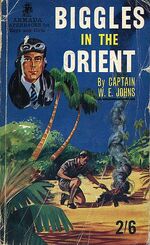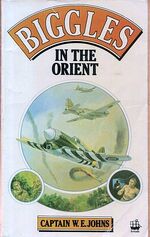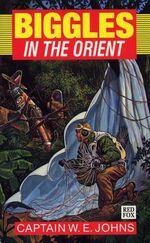Biggles in the Orient by W. E. Johns was first published in 1944 by Hodder and Stoughton. Since then there have been at least 13 subsequent editions. Written towards the end of World War 2, it is set around 1944 mainly in India and features Biggles and his 666 Squadron. Besides introducing the entire squadron to the reader, the story features lots of different aircraft and a wide variety of geographical locales.
In 1966, the Antwerp based Studio Vandersteen published a comic strip in Dutch entitled Biggles in de Oriënt which is a loose adaptation of the story but in the Air Police setting of the 1960s!
Synopsis
Biggles and his squadron are urgently summoned to India to deal with a mystery. Someone or something is interfering with the aircraft on the India to China supply route. One by one, aircraft carrying vitally needed war supplies to China are disappearing but no one knows how or why. There is even talk that the Japanese have invented a death ray....
Plot
Note: The sections below contain spoilers. In particular, the plot subpage summarises the book narrative in detail.
Characters
Members of 666 Squadron
- Biggles
- Algy
- Ginger
- Bertie Lissie
- Angus MacKail
- 'Tex' O'hara
- Tug Carrington
- 'Taffy' Hughes
- Henry Harcourt
- 'Ferocity' Ferris
Other RAF
- Air Commodore Raymond - Biggles' boss
- Flight Lieutenant Johnny Crisp - flight commander of 818 Squadron.
- Pilot Officer Scrimshaw - pilot in 818 squadron.
- Flying Officer Bargent - South African pilot at Jangpur who insists on accompanying Biggles on a run to Chungking and loses a wager of 100 cigarettes to Biggles because they return safely.
- Squadron Leader Frayle - station commander at Jangpur.
- Sergeant Gray - fitter in 818 Squadron.
- Corporal Jones - storekeeper at Jangpur.
- Thomas Grafton Moorven - pilot of 818 Squadron. He dies in a crash after the raid on Manipur. Biggles parachutes down to examine the wreckage.
- Grainger
- Larkin
- Cratton - Blenheim pilot at Dum Dum.
- Group Captain Boyle - Station commander at Dum Dum.
Others
- Ali Mansur - mess manager, an ex-Askari who gives Biggles important leads about the case.
- Lal Din - mess steward.
- Kong Po - dhobi-wallah (laundryman) at Jangpur. An enemy agent, he tries to strangle Biggles but Biggle shot him instead.
- Larapindi - a wealthy merchant who runs the spy ring. He is killed when Biggles shoots down his escaping aircraft.
- Tahil - partner of Tahil and Larapindi.
Aircraft
- Capricorn - probably a Short Empire flying boat. Transported 666 Sqn to Malta and on to Alexandria
- Vickers Wellington - transported 666 Sqn from Alexandria to Baghdad and on to Karachi. Also the principal aircraft on the Jangpur-Chungking air route. Biggles flew one with Bargent on this route.
- Consolidated B-24 Liberator - transported 666 Sqn from Karachi to Calcutta.
- Hawker Typhoon - Biggles shuttled to Jangpur with it. Also used it in the big blitz.
- De Havilland Mosquito - Biggles flew one with Tug Carrington when he shadowed a Hurricane raid led by Johnny Crisp.
- Gipsy Moth float-plane - Tug Carrington flew one to retrieve Biggles from the jungle after he parachuted out to inspect Moorven's crash site.
- Hawker Hurricane - Johnny Crisp's 818 Squadron flies Hurricane fighter bombers. Angus Mackail flew and crashed one while escorting Tug Carrington's Moth. Ginger and Scrimshaw used two of them during Biggles' experiment at Gayhar.
- Bristol Beaufighter - flown by Johnny Crisp in the big blitz.
- Bristol Blenheim - two squadrons of these bombers were stationed at Calcutta
- Supermarine Spitfire - used by Biggles in his final battle with Larapindi.
- Mitsubishi Zero - enemy fighter often seen by Biggles and others in the skies above Burma but they never encountered any in battle.
- Mitsubishi bomber - there are a number of possible types for this such as the Mitsubishi G4M Betty or the Mitsubishi Ki-21 Sally. The most probable is the Mitsubishi G4M "Betty". See the article on this aircraft type for discussion. The Japanese sent 98 of them in a big blitz on Calcutta.
- Gull floatplane "VTT-XQL" - probably a Percival Gull. Larapindi's getaway plane which Biggles shoots down.
Places
Visited
- Calafrana, Malta
- Alexandria
- Hinaidi Airfield, Baghdad
- Drigh Road Airfield, Karachi
- Dum Dum Airport, Calcutta
- Jangpur - southern terminus of the India-China air route
- Chungking, China - northern terminus of the India-China air route
- A Bridge over the Manipur river - Johnny Crisp attacks it but then loses 3 pilots on the return trip
- Gayhar - a practice landing strip not far from Calcutta, likely a fictional place name
- Razlet Avenue, Calcutta - address of Larapindi, probably fictional
- Warehouse of Tahil and Larapindi - on the banks of the Hooghly River in Calcutta
Mentioned
- The mysterious aircraft disappearances also took place at other stations namely:
- Trichinoply, Madras
- Ceylon
- Darwin, Australia
Other Research Notes
- Biggles mentions that the registration of the Gull is "VTT-XQL". The actual prefix used in India then, and now, is "VT" and not "VTT".
- Besides 818, 910 squadron is also mentioned.
- Japanese pilots of World War 2 did not fly with parachutes. The downed Japanese pilots hiding in the Tahil and Larapindi warehouse could only have arrived there if they had survived after crash-landing their aircraft instead of baling out. But W. E. Johns may not have known this.
- Chronology. The need to attack a bridge on the Manipur river would indicate a date some time between February and July 1944 during the phase of the Burma Campaign when Japanese troops attempted to invade India by going through Manipur and attacking towards Imphal and Kohima.
Editions
With 14 editions in English and several in other languages, Biggles in the Orient ranks as one of the more popular and most frequently reprinted books. It combines a touch of oriental mystique, lots of air combat, a wide variety of aircraft and some jungle action.
Interestingly, almost all of the cover art in the various English editions deal with the jungle scenes in Chapters 5-6. One wonders why. It is not a significant part of the plot.

Dustjacket of the first edition. Shows Biggles helping Angus Mackail out of the river.
- London: Hodder & Stoughton, November 1944. 180 pages with a colour frontispiece and 12 black/white illustrations by Stead. Blue boards. 19 cm.
- Dustjacket in full color shows the scene in Chapter 6 where Biggles rescues Angus Mackail out of the river. The tail of Mackail's crashed Hurricane can be seen in the water in the background. Letters in yellow.
- Ebay prices between 50USD and 200USD have been seen, depending on condition.
- Toronto: Musson (Adventure Books for Boys), 1946.
- London: Hodder & Stoughton, August 1948, 2nd impression. Similar to 1st edition.
- London: Hodder & Stoughton, October 1949, 3rd impression. Similar to 1st edition except blue-green boards.
- London: Hodder & Stoughton, 1952, 4th impression. Siliar to 1st edition except red boards.

Cover of the 1963 Armada paperback. Biggles is lighting a fire in the jungle--hardly the most dramatic scene in the book!
- London: Armada Books, 1963. 160 pages. Paperback. 18 cm.
- Cover largely blue. Biggles in flying jacket and tie at top left. Main artwork shows the scene in Chapter 6 where Biggles lights a fire to signal to Tug Carrington his position. Tug will shortly pick him up in the Moth floatplane. Price on cover 2/6.
- There is some info about a reprint in 1963 with different cover art. To be confirmed.
- London: Armada Books, no date: presumed 1965.
- London: Armada Books, no date: presumed 1969.

Cover of the 1969 Armada edition. An air battle at last! Biggles in his Typhoon shoots down several bombers which look like "Betty"s--note the bulbous tail section.
- London: Armada Books, 1969.
- London: Armada Books, 1970.
- London: Armada Books, 1974.

The 1980 Armada edition also depicts an air battle but the bombers do not look like "Betty"s. From the tail section they are more like Ki-21 "Sally"s, also plausible.
- London: Armada Books, 1980. 160 pages. Paperback. 18 cm. ISBN 0006917518.
- Cover largely white, main illustration of an air battle featuring a Typhoon in the foreground and several bombers in the background, all set within a circle. Two smaller illustrations in smaller circles bottom left and right.One depicts the scene in Chapter 6 of Biggles hiding from two Japanese soldiers at the site of Thomas Moorven's crash. The other depicts the scene in chapter 14, Biggles going after the assassin Kong Po.

The 1992 Red Fox edition. Again the setting is the jungle in Chapter 6. Biggles has parachuted down to inspect Thomas Moorven's crashed Hurricane.
- London: Red Fox, 1992. 190 pages. Paperback. 18 cm. ISBN 9780099938309.
- Cover art shows Biggles in parachute shrouds. He has just parachuted into the Burmese jungle to inspect Thomas Moorven's crashed Hurricane. Back cover lists price as GBP3.50.
- London: Red Fox, 1993
